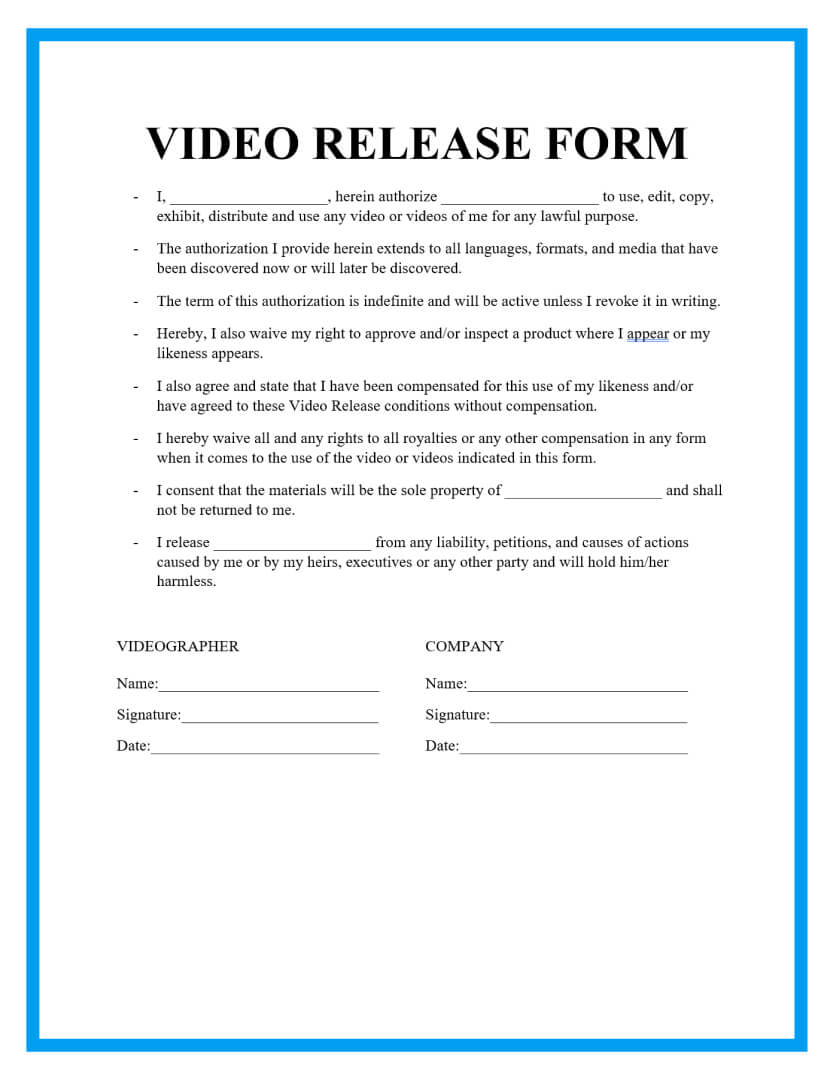
Whether you’re a filmmaking hobbyist or a full-blown production house, it’s crucial to understand the importance of a video release form and its use.

Whether you’re a filmmaking hobbyist or a full-blown production house, it’s crucial to understand the importance of a video release form and its use.
To make it easy for you, we’ve worked with legal experts and proofreaders to create a simple video release form (PDF and Word) for you to use when you need it.
Click below to grab a copy of our video release form templateObtaining a signed video release form is one of the most overlooked steps in the video production process.
In an attempt to make the best possible video for a project, you may inadvertently capture branding, people, private property, or minors. You then go on to publish and share your work for commercial purposes.
This situation can have significant legal implications as you didn’t take the time to get consent from your subjects to be in your film. Essentially, you’re violating your subjects’ privacy and making money from their presence—which is a big no-no!
A video release form is a legally binding contract between a videographer and a subject where the subject transfers the ownership of the footage to the filmmaker.
DISCLAIMER: We are not lawyers or a law firm and we do not provide legal, business or tax advice. We recommend you consult a lawyer or other appropriate professional before using any templates or agreements from this website.
As a videographer, it’s better to be safe than sorry when it comes to privacy and copyright. Save yourself the time, hassle, and headaches and use our free video release form, so you can focus on creating beautiful films.
Click below to download our template todayFirstly, you only need to get consent from subjects if you plan on using a video for commercial purposes.
If, for example, you’re using a film for your personal library or editorial, then you don’t require a video release.
If you’re producing films for commercial purposes, then there are quite a few situations where you’ll need to use a standard video release form, including capturing footage of:
You don’t need a video consent form if the subject or location is unidentifiable. For example, you can capture footage of random bushland that looks similar to many other landscapes. Or you record a generic meal on a plate, and it’s almost impossible to tell who owns it.
As long as you can prove that your subject is unidentifiable beyond a reasonable doubt, then a release form isn’t required.
If you’re interested in learning more about video release forms, check out the video below.As a videographer, it’s better to be safe than sorry when it comes to privacy and copyright. Save yourself the time, hassle, and headaches and use our free video release form, so you can focus on creating beautiful films.
Click below to download our template todaySo let’s say you’ve planned a filming project and you want to capture an identifiable subject that a person owns, how do you approach them with your form?
It can be quite confronting to explain your video release policy, especially to strangers!The first thing is first, make sure you have your video release form on hand. It will be tempting to proceed without the documents, or trust that the models will sign them later, but it’s essential to hold off the shoot until you have the signed documents.
When presenting the film release form template, try not to make a big deal of it. Tell your client that you need them to sign your video release before proceeding with the shoot. Ask them to read over your form and sign when they’re ready.
More often than not, clients will read through your contract and sign it without any questions asked. After all, they’d likely know in advance that you’re a videographer and expected that you’d have ownership over the footage.
If they do have questions about your release form, calmly and firmly address their queries. Sometimes it’s worth explaining how you’ll be using the media to put the clients’ minds at ease.
You could take it a step further and give them examples of how you’ve used client media in the past. This creates a level of normalcy with the nature of your work.